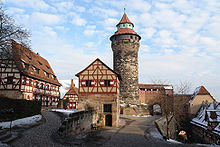- Nuremberg Castle
-
Nuremberg Castle (German: Nürnberger Burg) is a historical building on a sandstone rock in the north of the historical city of Nuremberg, Bavaria, Germany. It comprises three sections: the imperial castle ("Kaiserburg"), some buildings of the Burgraves of Nuremberg ("Burggrafenburg"), and the municipal buildings of the Imperial City at the eastern site ("Reichsstädtische Bauten").
History
Archeological investigations during recent days indicate that the place was already settled around the year 1000, although this has not been backed up by any documentary proof. Nuremberg was first recorded in 1050, when Henry III visited the town, but there is no specific mention of the castle. The castle does not appear in any documents until 1105.
In 1140, King Conrad III started building a second castle on the site, to be used as a royal residence.
In the 13th century, Nuremberg became an Imperial Free City, and the castle fell into the care of the city. Of all the parts of the castle built during this time, the Luginsland Tower ("watch-over-the-land" Tower), begun in 1377, stands out.
Legend has it that in 1381, the robber baron Eppelein von Gailingen escaped death on the gallows when his horse leapt into the castle moat. It is said that at this certain place the imprints of his horse's hoofs are still visible in the fortification wall.[1]
In the second quarter of the 19th century, measures were taken to preserve the buildings, in particular by Carl Alexander Heideloff, August von Voit and August Essenwein.
In World War II, the castle was damaged in 1944-45, with only the Roman double chapel and the Sinwell Tower remaining entirely intact. After the war, the castle was restored under the direction of Rudolf Esterer and Julius Lincke to its historical form, including the Luginsland tower which had been completely destroyed. The additions of the 19th century has been partly removed in 1934/35.
Today, the eastern municipal buildings of the castle (Kaiserstallung and Luginsland) are used as a youth hostel.
Sources
- Mummenhoff, Ernst, 1926: Die Burg zu Nürnberg. Geschichtlicher Führer für Einheimische und Fremde (4th edition, reprinted 1997, with an afterword by the editor G. Ulrich Grossmann) Nuremberg
- ^ http://www.nordbayern.de/nuernberger-nachrichten/region-bayern/raubritter-als-galionsfigur-1.530937 (German)
Coordinates: 49°27′28″N 11°04′33″E / 49.45778°N 11.07583°E
Categories:- Castles in Bavaria
- Buildings and structures in Nuremberg
- Imperial castles
- German castle stubs
- Bavaria building and structure stubs
Wikimedia Foundation. 2010.



